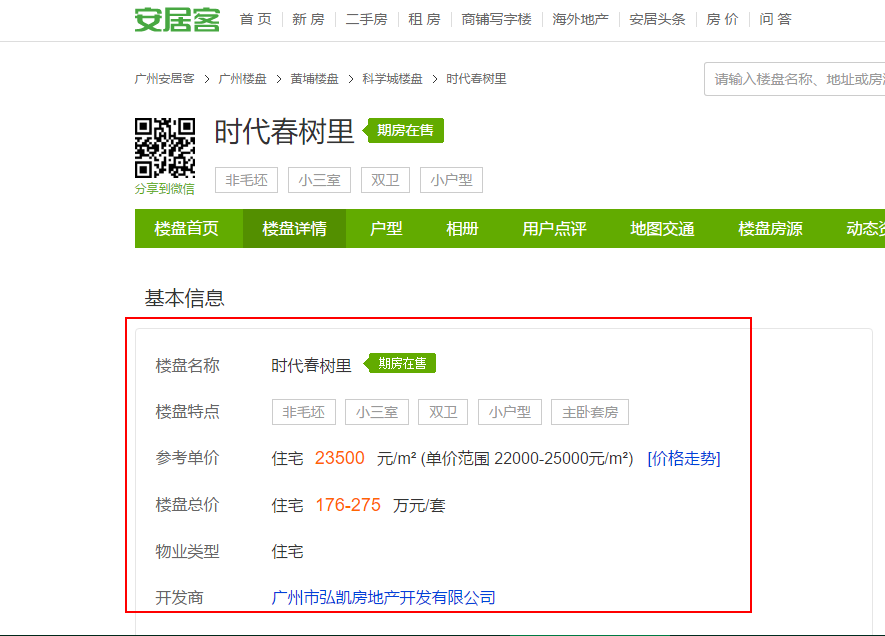需求:爬取【安居客—广州—新楼盘】的数据,具体到每个楼盘的详情页的若干字段。
难点:楼盘类型各式各样:住宅 别墅 商住 商铺 写字楼,不同楼盘字段的名称不一样。然后同一种类型,比如住宅,又分为不同的情况,比如分为期房在售,现房在售,待售,尾盘。其他类型也有类似情况。所以字段不能设置固定住。
解决方案:目前想到的解决方案,第一种:scrapy中items.py中不设置字段,spider中爬的时候自动识别字段(也就是有啥字段就保留下来),然后返回字典存起来。第二种,不同字段的网页分别写规则单独抓取。显然不可取。我采用的是第一种方案。还有其他方案的朋友们,欢迎交流哈。
目标网址为:http://gz.fang.anjuke.com/ 该网页下的楼盘数据

示例楼盘网址:http://gz.fang.anjuke.com/loupan/canshu-298205.html?from=loupan_tab

开始编写scrapy脚本。建立工程步骤略过。

1、count.py
1 __author__ = 'Oscar_Yang' 2 #-*- coding= utf-8 -*- 3 """ 4 查看mongodb存储状况的脚本count.py 5 """ 6 import time 7 import pymongo 8 client = pymongo.MongoClient("localhost", 27017) 9 db = client["SCRAPY_anjuke_gz"] 10 sheet = db["anjuke_doc1"] 11 12 while True: 13 print(sheet.find().count()) 14 print("____________________________________") 15 time.sleep(3)
1 """ 2 entrypoint.py 3 """ 4 from scrapy.cmdline import execute 5 execute(['scrapy', 'crawl', 'anjuke_gz'])
1 # -*- coding: utf-8 -*- 2 """ 3 settings.py 4 """ 5 6 # Scrapy settings for anjuke_gz project 7 # 8 # For simplicity, this file contains only settings considered important or 9 # commonly used. You can find more settings consulting the documentation: 10 # 11 # http://doc.scrapy.org/en/latest/topics/settings.html 12 # http://scrapy.readthedocs.org/en/latest/topics/downloader-middleware.html 13 # http://scrapy.readthedocs.org/en/latest/topics/spider-middleware.html 14 15 BOT_NAME = 'anjuke_gz' 16 17 SPIDER_MODULES = ['anjuke_gz.spiders'] 18 NEWSPIDER_MODULE = 'anjuke_gz.spiders' 19 MONGODB_HOST = "127.0.0.1" 20 MONGODB_PORT = 27017 21 MONGODB_DBNAME="SCRAPY_anjuke_gz" 22 MONGODB_DOCNAME="anjuke_doc1" 23 24 # Crawl responsibly by identifying yourself (and your website) on the user-agent 25 #USER_AGENT = 'anjuke_gz (+http://www.yourdomain.com)' 26 27 # Obey robots.txt rules 28 ROBOTSTXT_OBEY = False 29 30 # Configure maximum concurrent requests performed by Scrapy (default: 16) 31 #CONCURRENT_REQUESTS = 32 32 33 # Configure a delay for requests for the same website (default: 0) 34 # See http://scrapy.readthedocs.org/en/latest/topics/settings.html#download-delay 35 # See also autothrottle settings and docs 36 #DOWNLOAD_DELAY = 3 37 # The download delay setting will honor only one of: 38 #CONCURRENT_REQUESTS_PER_DOMAIN = 16 39 #CONCURRENT_REQUESTS_PER_IP = 16 40 41 # Disable cookies (enabled by default) 42 #COOKIES_ENABLED = False 43 44 # Disable Telnet Console (enabled by default) 45 #TELNETCONSOLE_ENABLED = False 46 47 # Override the default request headers: 48 #DEFAULT_REQUEST_HEADERS = { 49 # 'Accept': 'text/html,application/xhtml+xml,application/xml;q=0.9,*/*;q=0.8', 50 # 'Accept-Language': 'en', 51 #} 52 53 # Enable or disable spider middlewares 54 # See http://scrapy.readthedocs.org/en/latest/topics/spider-middleware.html 55 #SPIDER_MIDDLEWARES = { 56 # 'anjuke_gz.middlewares.AnjukeGzSpiderMiddleware': 543, 57 #} 58 59 # Enable or disable downloader middlewares 60 # See http://scrapy.readthedocs.org/en/latest/topics/downloader-middleware.html 61 #DOWNLOADER_MIDDLEWARES = { 62 # 'anjuke_gz.middlewares.MyCustomDownloaderMiddleware': 543, 63 #} 64 65 # Enable or disable extensions 66 # See http://scrapy.readthedocs.org/en/latest/topics/extensions.html 67 #EXTENSIONS = { 68 # 'scrapy.extensions.telnet.TelnetConsole': None, 69 #} 70 71 # Configure item pipelines 72 # See http://scrapy.readthedocs.org/en/latest/topics/item-pipeline.html 73 ITEM_PIPELINES = { 74 'anjuke_gz.pipelines.AnjukeGzPipeline': 300, 75 } 76 77 # Enable and configure the AutoThrottle extension (disabled by default) 78 # See http://doc.scrapy.org/en/latest/topics/autothrottle.html 79 #AUTOTHROTTLE_ENABLED = True 80 # The initial download delay 81 #AUTOTHROTTLE_START_DELAY = 5 82 # The maximum download delay to be set in case of high latencies 83 #AUTOTHROTTLE_MAX_DELAY = 60 84 # The average number of requests Scrapy should be sending in parallel to 85 # each remote server 86 #AUTOTHROTTLE_TARGET_CONCURRENCY = 1.0 87 # Enable showing throttling stats for every response received: 88 #AUTOTHROTTLE_DEBUG = False 89 90 # Enable and configure HTTP caching (disabled by default) 91 # See http://scrapy.readthedocs.org/en/latest/topics/downloader-middleware.html#httpcache-middleware-settings 92 HTTPCACHE_ENABLED = True 93 HTTPCACHE_EXPIRATION_SECS = 0 94 HTTPCACHE_DIR = 'httpcache' 95 HTTPCACHE_IGNORE_HTTP_CODES = [] 96 HTTPCACHE_STORAGE = 'scrapy.extensions.httpcache.FilesystemCacheStorage'
接下来,是items。因为没有设置字段,为默认的代码。
1 # -*- coding: utf-8 -*- 2 3 # Define here the models for your scraped items 4 # 5 # See documentation in: 6 # http://doc.scrapy.org/en/latest/topics/items.html 7 8 import scrapy 9 10 11 class AnjukeGzItem(scrapy.Item): 12 # define the fields for your item here like: 13 # name = scrapy.Field() 14 pass
接下来,是piplines.py。在中设置了mongodb的配置。
# -*- coding: utf-8 -*- # Define your item pipelines here # # Don't forget to add your pipeline to the ITEM_PIPELINES setting # See: http://doc.scrapy.org/en/latest/topics/item-pipeline.html import pymongo from scrapy.conf import settings class AnjukeGzPipeline(object): def __init__(self): host=settings["MONGODB_HOST"] port=settings["MONGODB_PORT"] dbname=settings["MONGODB_DBNAME"] client=pymongo.MongoClient(port=port,host=host) tdb = client[dbname] self.post=tdb[settings["MONGODB_DOCNAME"]] def process_item(self,item,spider): info = dict(item) self.post.insert(info) return item
最后,是最主要的spider.py
1 from scrapy.http import Request 2 import scrapy 3 from bs4 import BeautifulSoup 4 import re 5 import requests 6 """ 7 spider脚本 8 """ 9 class Myspider(scrapy.Spider): 10 name = 'anjuke_gz' 11 allowed_domains = ['http://gz.fang.anjuke.com/loupan/'] 12 start_urls = ["http://gz.fang.anjuke.com/loupan/all/p{}/".format(i) for i in range(39)] 13 14 def parse(self, response): 15 soup = BeautifulSoup(response.text,"lxml") 16 content=soup.find_all(class_="items-name") #返回每个楼盘的对应数据 17 for item in content: 18 code=item["href"].split("/")[-1][:6] 19 real_href="http://gz.fang.anjuke.com/loupan/canshu-{}.html?from=loupan_tab".format(code) #拼凑出楼盘详情页的url 20 res=requests.get(real_href) 21 soup = BeautifulSoup(res.text,"lxml") 22 a = re.findall(r'<div class="name">(.*?)</div>', str(soup)) 23 b = soup.find_all(class_="des") 24 data = {} 25 for (i, j) in zip(range(len(b)), a): 26 data[j] = b[i].text.strip().strip(" ") 27 data["url"] = real_href 28 yield data
下面是存入mongodb的情况。
因为针对不同的网页结构,爬取的规则是一个,所以爬取的时候就不能针对每个字段进行爬取,所以存到库里的数据如果要是分析的话还需要清洗。
在python中使用mongodb的查询语句,再配合使用pandas应该就很方便清洗了。
